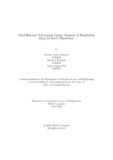| dc.contributor.advisor | Chakrabarty, Amitabha | |
| dc.contributor.author | Mahmud, Booshra Nazifa | |
| dc.contributor.author | Ferdoush, Zannatul | |
| dc.contributor.author | Mim, Lamia Tasnim | |
| dc.date.accessioned | 2019-07-14T05:22:06Z | |
| dc.date.available | 2019-07-14T05:22:06Z | |
| dc.date.copyright | 2019 | |
| dc.date.issued | 2019-04 | |
| dc.identifier.other | ID 15301020 | |
| dc.identifier.other | ID 15301068 | |
| dc.identifier.other | ID 15301052 | |
| dc.identifier.uri | http://hdl.handle.net/10361/12353 | |
| dc.description | This thesis is submitted in partial fulfillment of the requirements for the degree of Bachelor of Science in Computer Science and Engineering, 2019. | en_US |
| dc.description | Cataloged from PDF version of thesis. | |
| dc.description | Includes bibliographical references (pages 45-49). | |
| dc.description.abstract | Bangladesh being one of the ve fastest growing economies in the world with its
enormous 164.7 million population is facing a huge challenge of adapting to the
surging demand of electricity rising throughout the country to support its blooming
economy. Load forecasting can play a vital role to overcome this challenge as it
serves as an imperative tool behind electric utilities planning and operation management.
Forecast loads serve as the basis of many operational decisions such ensuring
maximum utilization of power by avoiding under or over generation; understanding
future load demand to make economically viable investment decisions; management
of resources; infrastructure development along with maintenance schedule planning.
This study, rst of all, proposes an automated model that fetches data from daily
load generation reports (kept in pdf format) found in the Bangladesh Power Development
Boards website [54] to generate a compact dataset of our historical load
data with which we have conducted this research. The necessity of this model is
no publicly available dataset have been found so far that contains the historical
load data along with data of other important features that e ect the forecast load.
Secondly, we have approached three major machine learning methods { K Nearest
Neighbor, Random Forest, and Long Short Term Memory (LSTM) to observe how
these algorithms perform in forecasting load based on the historical electric load
data of Bangladesh and what features play important roles to accurately forecast
load. We have found that among these three algorithms; LSTM yields the best
result having minimal prediction error compared to the other algorithms. | en_US |
| dc.description.statementofresponsibility | Mahmud, Booshra Nazifa | |
| dc.description.statementofresponsibility | Ferdoush, Zannatul | |
| dc.description.statementofresponsibility | Lamia Tasnim Mim | |
| dc.format.extent | 49 pages | |
| dc.language.iso | en | en_US |
| dc.publisher | Brac University | en_US |
| dc.rights | Brac University theses are protected by copyright. They may be viewed from this source for any purpose, but reproduction or distribution in any format is prohibited without written permission. | |
| dc.subject | Load forecast | en_US |
| dc.subject | Prediction | en_US |
| dc.subject | Decision tree | en_US |
| dc.subject | Random forest | en_US |
| dc.subject | K Nearest | en_US |
| dc.subject | Long Short Term Memory | en_US |
| dc.subject.lcsh | Machine learning | |
| dc.subject.lcsh | Decision trees | |
| dc.title | Modelling and forecasting energy demand of Bangladesh using AI based algorithms | en_US |
| dc.type | Thesis | en_US |
| dc.contributor.department | Department of Computer Science and Engineering, Brac University | |
| dc.description.degree | B. Computer Science and Engineering | |

